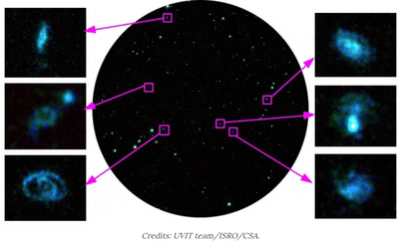
In what could be the second major discovery in less than a year, Indian Space Research Organization's (ISRO) first dedicated multi-wavelength space observatory Astrosat has captured an image of a special galaxy cluster. The Galaxy cluster is located more than 800 million light-years away. Remarkably, Astrosat also discovered a faint dwarf galaxy – Wolf-Lundmark-Melotte (WLM) – that is located three million light years away from the earth.
The galaxy cluster named Abell 2256, is made of three separate clusters of galaxies that are all merging with one another. The scientists are of the view that this will eventually form a single massive cluster in the future. These three merging clusters have more than 500 galaxies and almost 100 times larger and more than 1,500 times massive as compared to our own Milky Way Galaxy.
The Indian Space Research Organisation posted the details on its website and informed that this is the most distant Astrosat Picture of the Month (APOM) so far. ISRO says that the merger of the three galaxy cluster has produced a rich diversity of structures that have been imaged in radio wavelengths by every radio telescope in the world.
Astronomers zoomed in on six of these galaxies to capture ultraviolet images, though the cluster contains galaxies spread over a large area. To capture the images of these galaxies, Astronomers used Ultra Violet Imaging Telescope (UVIT), one of the five instruments onboard Astrosat.
Astronomers explain that galaxy clusters are places where many spiral galaxies transform slowly into lenticular and elliptical galaxies. Spiral galaxies, like our own Milky Way, are bluer in colour and are forming stars constantly. Elliptical and lenticular galaxies, however, are redder and have mainly old stars in them. Abell 2256 is one such galaxy cluster where astronomers believe many galaxies are going through this metamorphosis.
Astrosat is India's first dedicated multi-wavelength space observatory. It was launched on a PSLV-XL on 28 September 2015. With the success of this satellite, ISRO has proposed to launch AstroSat-2 as a back for Astrosat when nears its five-year lifespan.

















